There have been years when I’ve sat down to write the Deep Dive into our annual report and struggled to find a place to focus.
This is not one of those years.
My main struggle in trying to take you through the data we collected and analyzed in 2024 and 2025 is not finding a critical takeaway, but in prioritizing which ones to emphasize the most.
There are so many keys in this data, I can’t in good conscience leave any of them on the ground. So this year’s deep dive is going deep, and also wide. In the sections below I’m going to be sharing what I believe are the most critical takeaways from the 8th annual State of Agile Marketing Report, and I won’t be pulling any punches.
Marketers are facing make-or-break decisions on many fronts right now, and this is not the time to be timid.
I’ll be telling it like it is, and I hope you’ll take what I share and put it to work for you. If you do, let me know how it goes – we’re all in this together, and the more we share our knowledge, the better off we’ll all be.
Table of Contents:
What Are Marketers Focused on in 2025?
First, a note about timing: we began collecting responses very late in 2024, with the survey closing in early 2025. As I write this, sweeping tariffs have been announced and recession fears are mounting here in the US, but none of that was top of mind for marketers when they gave us their responses.
At the time, here’s what marketers told us they were focused on:
At the time, here’s what marketers told us they were focused on:
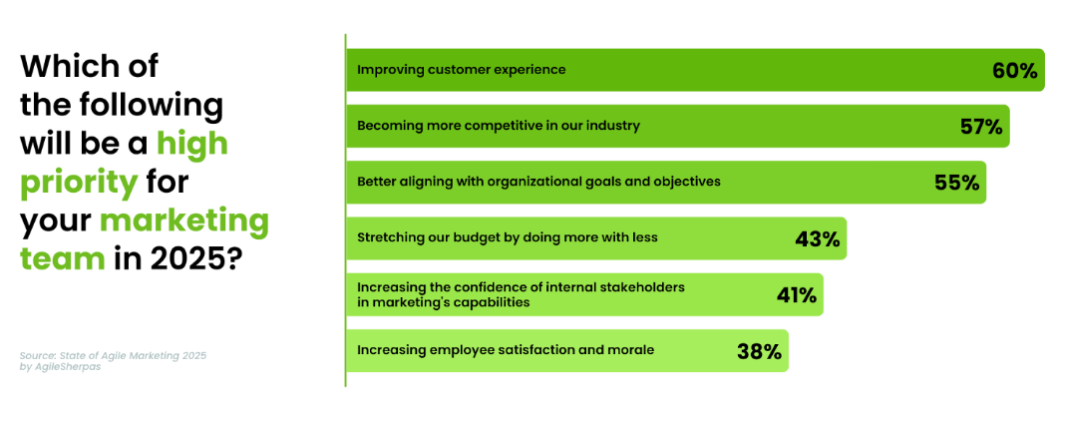
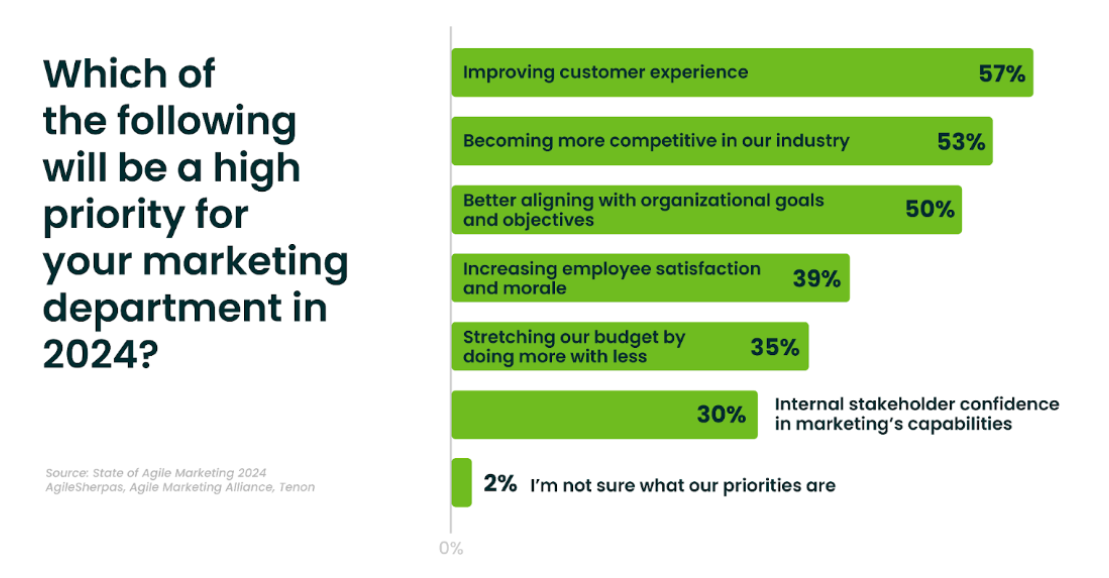
There seems to be a long term perspective informing the top three results that’s encouraging. Customer experience is something marketers should be perpetually concerned with, and staying in sync with the organization is always mission-critical.
It’s encouraging to see how our respondents were focused on driving value long term, but I can’t help but wonder whether their C-suite shares this focus when it comes to marketing investments.
Part of that wondering comes from the fact that I see a lot more zero-sum approaches right now, which I think we’re seeing come out in how high competitiveness is ranking. For most industries, there’s just not as much cash flying around as there has been in years past, which means it’s critical to stand out from competitors.
In some ways I’m glad to see the “do more with less” truism come in fourth place, since this is often code for “work more without getting paid extra.”
But the fact that 43% of the respondents are still giving this “high priority” status means that it’s a mindset that remains pervasive. And, if we take a quick glance back to 2024, we can see that there’s an 8% year over year increase in marketers who cite this as a priority.
In one other interesting trend, the total percentage of respondents who said that “increasing employee morale” was high on their list stayed nearly the same (39% last year; 38% this year), but it was surpassed by both increasing internal stakeholder alignment and doing more with less.
Given the conversations I’ve been having with all kinds of folks in the industry, this tracks overall sentiment in Q2 of 2025.
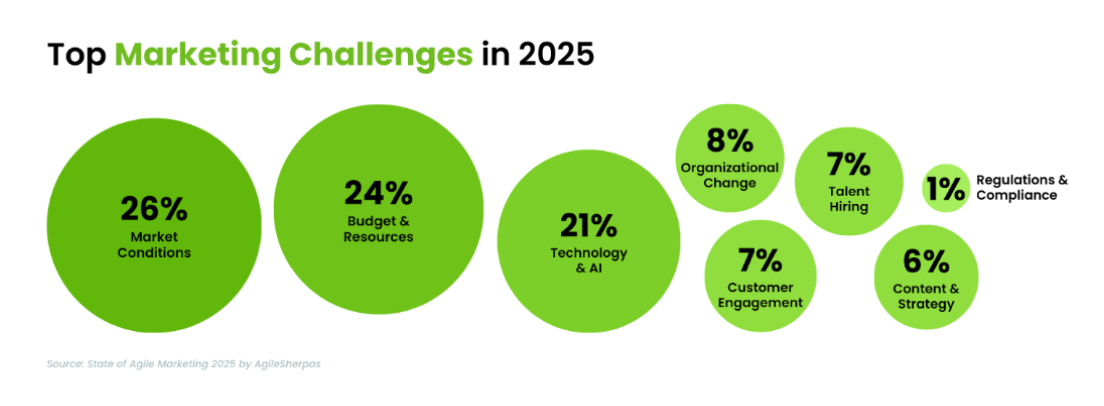
I often think of the challenges question as, “what’s standing in the way of marketers accomplishing their stated goals”? Interestingly, this year we have a lot of things that feel outside of our control coming in at the top of the list.
Market conditions? Can’t change that.
Budget? We’d always like more.
Technology and AI? Anybody know where the pause button is?!?
But, while these are all things we may not be able to meaningfully influence, we can do our best within the circumstances we have.
As we’ll see later, full agility can help marketing teams respond effectively to uncertain market conditions, maximize whatever budget and headcount they have, and incorporate new AI and technological capabilities in a rigorous, disciplined way.
So yes, we have challenges in marketing in 2025. But we also have the tools we need to meet them head on.
What Role Is AI Playing in Marketing Processes and Success Rates?
Despite the near-hourly announcement of some new AI tool, LLM update, or outright expansion of functionality, few marketers have “fully integrated” AI into their processes. Our data shows only 17% would label their rollout this way, and in conversation with Jessica Hreha of Jasper.ai and John Arnott of C1M they agreed that this number is probably the highest that’s realistic to expect.
It’s possible that far fewer marketers have actually achieved full integration of AI, especially if we consider agents and not just conversational AI.
But that doesn’t mean AI is not on our radar; only 7% of the marketers we surveyed said they’re not considering AI at all.
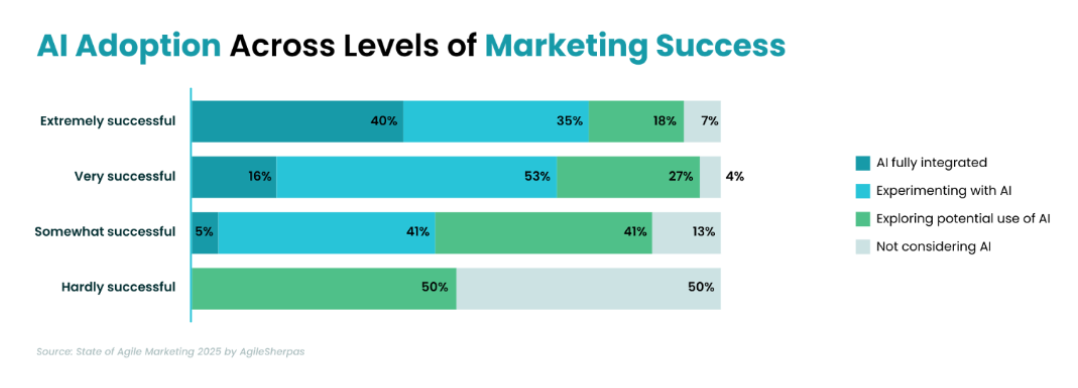
Of course, just like Agile, we shouldn’t be rolling out AI “just because.”
Any new AI intervention, whether that’s a custom GPT, a tailor-made agent, or an off-the-shelf tool, should serve a need and solve a problem.
In the above chart, we see that the most successful marketing teams are getting this right. Forty percent put themselves into the “full integrated” category, and that drops by more than half at the “very successful” level.
Given the high correlation that we can see in our sample between AI and success, this should be top of mind for marketing leaders everywhere.
Of course, just like Agile, we shouldn’t be rolling out AI “just because.”
Any new AI intervention, whether that’s a custom GPT, a tailor-made agent, or an off-the-shelf tool, should serve a need and solve a problem.
In the above chart, we see that the most successful marketing teams are getting this right. Forty percent put themselves into the “full integrated” category, and that drops by more than half at the “very successful” level.
Given the high correlation that we can see in our sample between AI and success, this should be top of mind for marketing leaders everywhere.
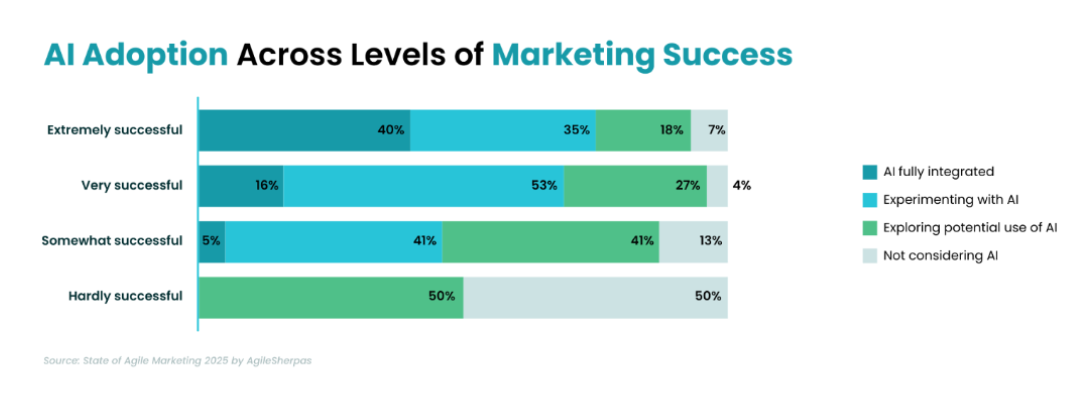
And of course, this is a report all about marketing agility, so we wouldn’t be doing our job if we didn’t explore the link between AI adoption and agility.
Two things we need to underline here:
- In our data set of 430 responses, there was not one non-Agile team that had fully integrated AI
- Fully Agile teams (compared to teams that label themselves only “somewhat Agile”) are 3x more likely to have fully implemented AI
Let’s make this as straightforward as possible: implementing AI is correlated with higher levels of marketing success, and a fully Agile way of working.
If you want to be a successful marketing team in 2025, you need both AI and agility.
Why Every Marketing Team Should Be an Agile Marketing Team in 2025
Yes, agility makes AI adoption easier to pull off, but that’s not the only reason that process improvement should be at the top of everyone’s to-do list this year.
It turns out the benefits between AI and agility are bi-directional. In other words, AI is making agility easier too.
Two thirds of our respondents reported that their use of AI has enhanced their agility, which means the smartest teams are pushing on both fronts. They’re implementing better ways of working combined with cutting-edge tools and technology.
And again, this isn’t just so that we can say we’re “on the cutting edge.”
Higher levels of agility are strongly correlated with marketing success: when a team feels they are “fully Agile,” they’re also 3x more likely to say they’re extremely successful.

In fact, 9 out of 10 Agile marketing teams label themselves as either “extremely successful” or “very successful.”
There’s not a much stronger indication that agility = success.
Marketing Agility and Productivity are Linked
Of course, success can come in many flavors. One of those is the ability to simply get work done, also known as productivity.
In a fully Agile environment, we come back again to a 3x improvement: compared to their “somewhat Agile” counterparts, fully Agile teams are 3x more likely to say they’ve significantly increased their productivity.
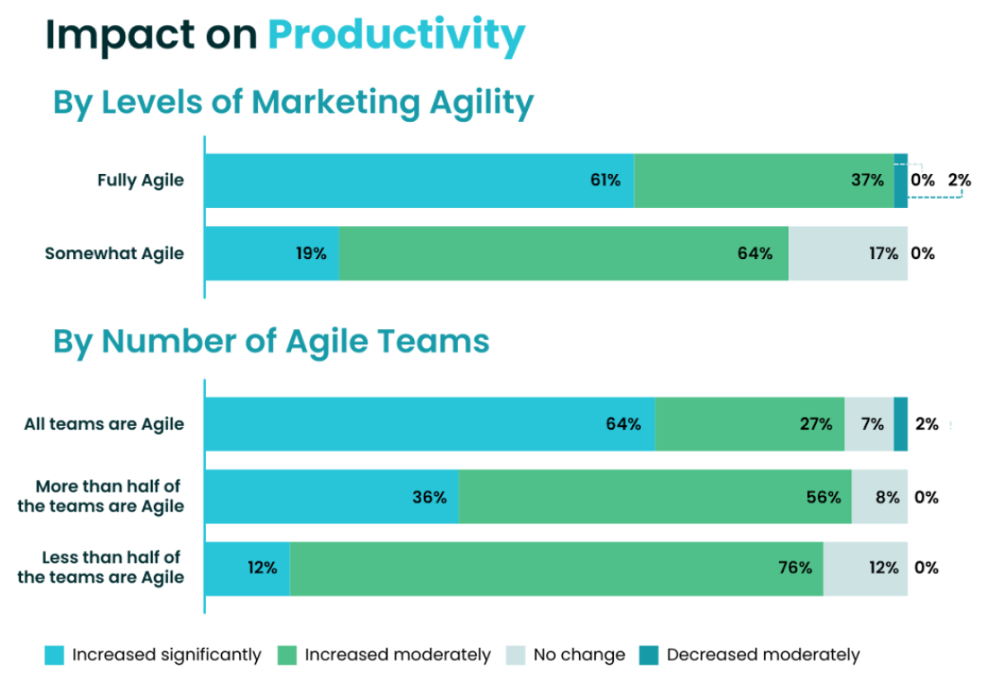
This trend holds true when we look at the number of Agile teams as well: more agility leads to higher levels of productivity.
This isn’t hard to understand. If you’re passing projects or initiatives back and forth between Agile and non-Agile teams, the chances go way up that collaboration drag will creep in and productivity will decline.
Higher Agility Reduces Stress and Burnout
Productivity and agility are nice, but we don’t want to pursue them at all costs. If we burn all our employees out, we’ll inevitably see a decline in quality and engagement.
In marketing, this can easily manifest as lower quality and effectiveness of the work we do.
Happily, we continue to see strong connections between agility and job satisfaction. Specifically, if we look at stress and burnout levels, full agility leads to a 6x increase in the likelihood that marketers will feel much less stressed.

For leaders, this is a critical differentiator that can help you hang on to your top talent.
For marketers, this lets you do a lot of great work without being pushed to extremes.
Other benefits that are worth pointing out are below; let’s zoom in on just a few:
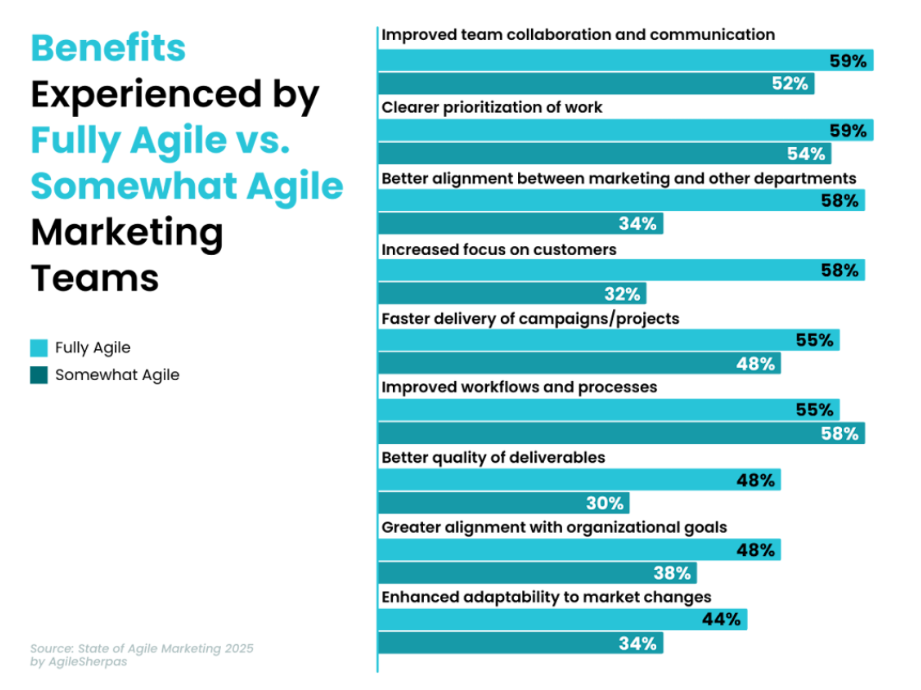
- Customer focus, which you may remember was the top priority of marketers for this year according to our data, is significantly improved (+26 percentage points) by full agility.
- Alignment, another top priority, also goes way up. In this case it’s a +24 percentage point jump.
- Last, but certainly not least, the quality of deliverables goes up by 18 percentage points when full agility is present.
Getting everybody to work the same way isn’t easy; it requires change management and diligent oversight. But it’s clear that pushing for this universal level of adoption brings multiple benefits that more than justify the investment.
What’s the Difference Between Fully and Partially Agile Marketing Teams?
Now that we’ve seen the benefits of full agility, let’s move further upstream and see what the different behaviors are between fully and partially Agile marketing teams.
This is a critical step, because it allows you to figure out where your operational gaps are so you can move closer to the benefits that fully Agile teams enjoy.
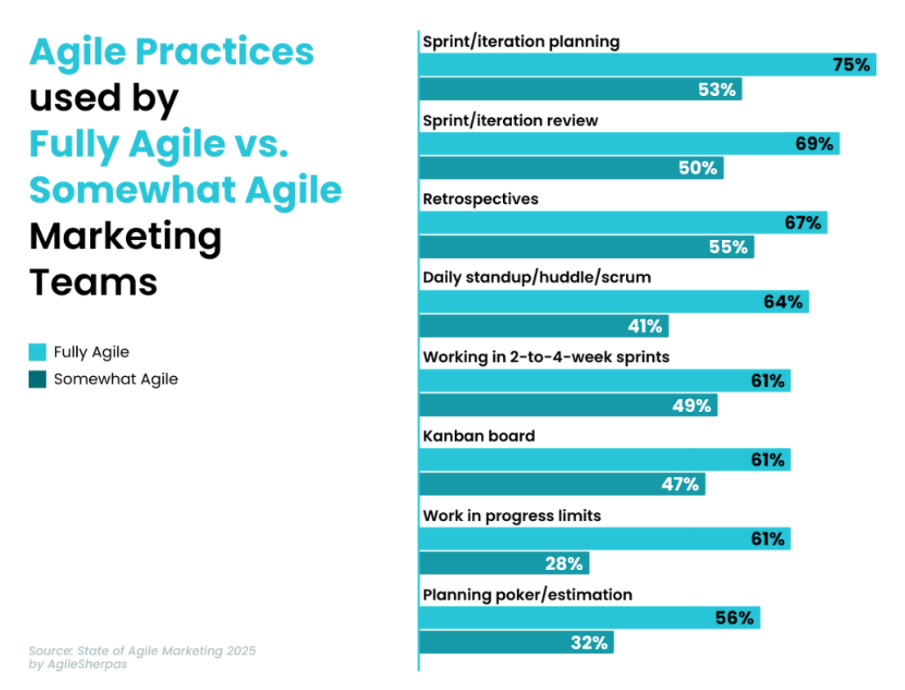
First and foremost we see that fully Agile teams tend to work in sprints. While this is a practice usually associated with the Scrum framework, we intentionally distinguish its components in this list.
Marketers typically pull bits and pieces of Scrum out and apply them ad hoc, which is a totally fine way of evolving a team’s ways of working. We can see that trend continued in the chart above through the use of sprint planning, reviews, retrospectives, and daily standups.
But, as you’ll notice, the percentages aren’t exactly equal across all of these practices. Some marketers use them all, while others pick and choose.
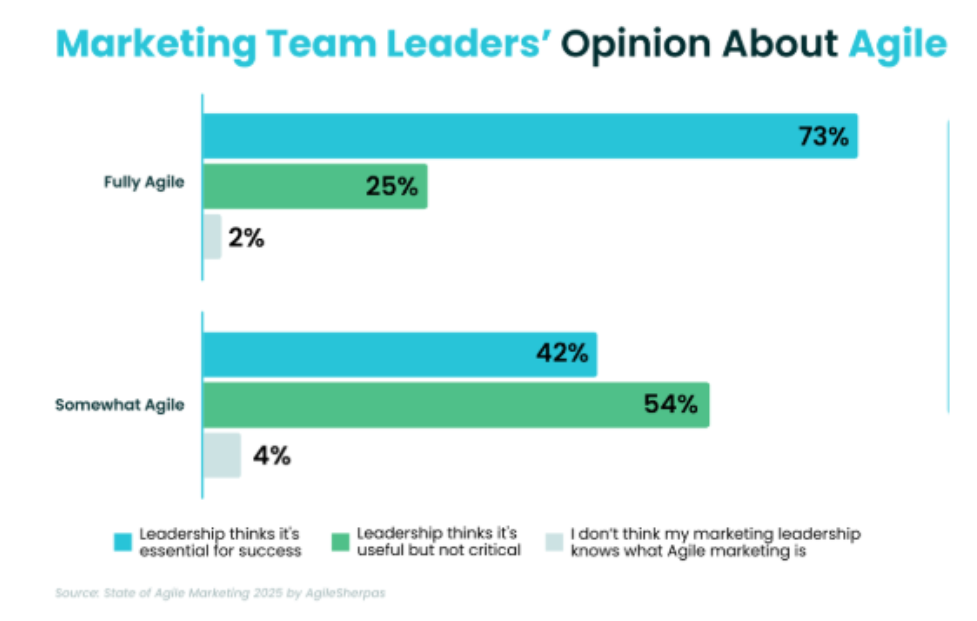
And of course, we can’t talk about complete agility until we talk about leadership buy-in.
And we can’t ignore the differences in leadership attitudes that we see in the above chart. When teams achieve full agility (and all the benefits that come with it), their leaders are 31 percentage points more likely to label Agile as essential to success.
When Agile is not completely adopted, leaders are more than twice as likely to say it’s a “nice to have,” useful but not critical to success.
In those kinds of environments, Agile will get pushed aside quite easily. When deadlines loom or crisis hits, leaders will prioritize the familiar. If that doesn’t include Agile ways of working for them, those activities will get cancelled.
Ironically, it’s in exactly those situations that agility can help the most, but without full adoption it’s much too easy to slip back into old styles.
How Successful Marketers Differ from their Peers
While full vs. partial agility is an important differentiator to explore, we also need to dig into the particular characteristics of the highly successful teams that we surveyed.
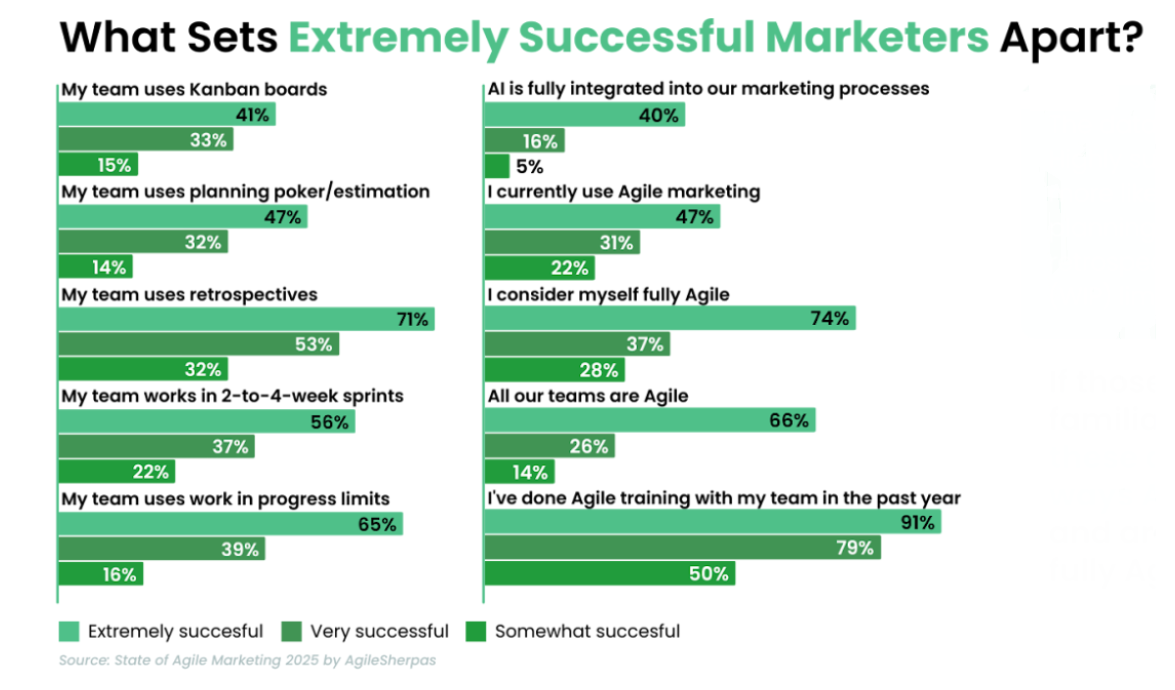
First we need to jump to the right hand column, where we see that nearly half of our most successful marketers are using Agile. Only 22% of those that say they’re only “somewhat successful” are Agile.
And if we compare the level of agility, the differences are even more pronounced:
- 74% of extremely successful marketers are fully Agile
- 66% of extremely successful marketers have all their teams transitioned to Agile
It’s clear that while the incorporation of some Agile practices is useful, it’s a holistic approach that yields the biggest impact.
Two other points here that we can’t move on without mentioning: AI integration is highly correlated with extremely successful teams, and both extremely successful teams and very successful ones are highly likely to have done training with their teams in the past year.
So if you’re looking for two quick action items that can lead to success, AI integration efforts and training should go into your backlog.
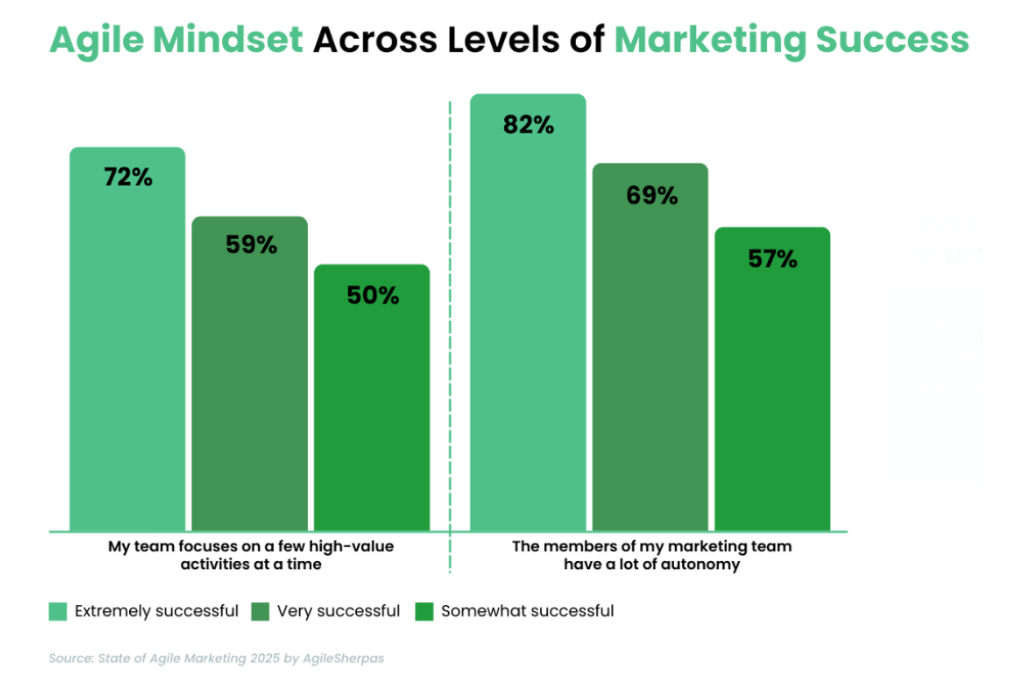
While the way we work obviously impacts our success, there are also ramifications from how we think.
Regardless of whether they use sprints or AI, the marketers who report the greatest sense of success are focused and independent.
They can clearly point their team’s efforts toward a few high-value activities, and execute them with a high degree of autonomy.
It’s important to underline this difference, because it can be easy to feel overwhelmed by all the Agile “stuff” that you should be doing. But everyone can improve their focus, and almost everyone can increase a team’s autonomy.
I recognize that the latter component is contingent on at least some level of support from leaders, but the former is doable even as an individual contributor with no Agile culture around you. Simply by making an individual backlog and using your own personal discipline to limit your work in progress, you’ll be able to get more done in less time.
Sometimes this alone is enough to catalyze interest in new practices from teammates and bosses.
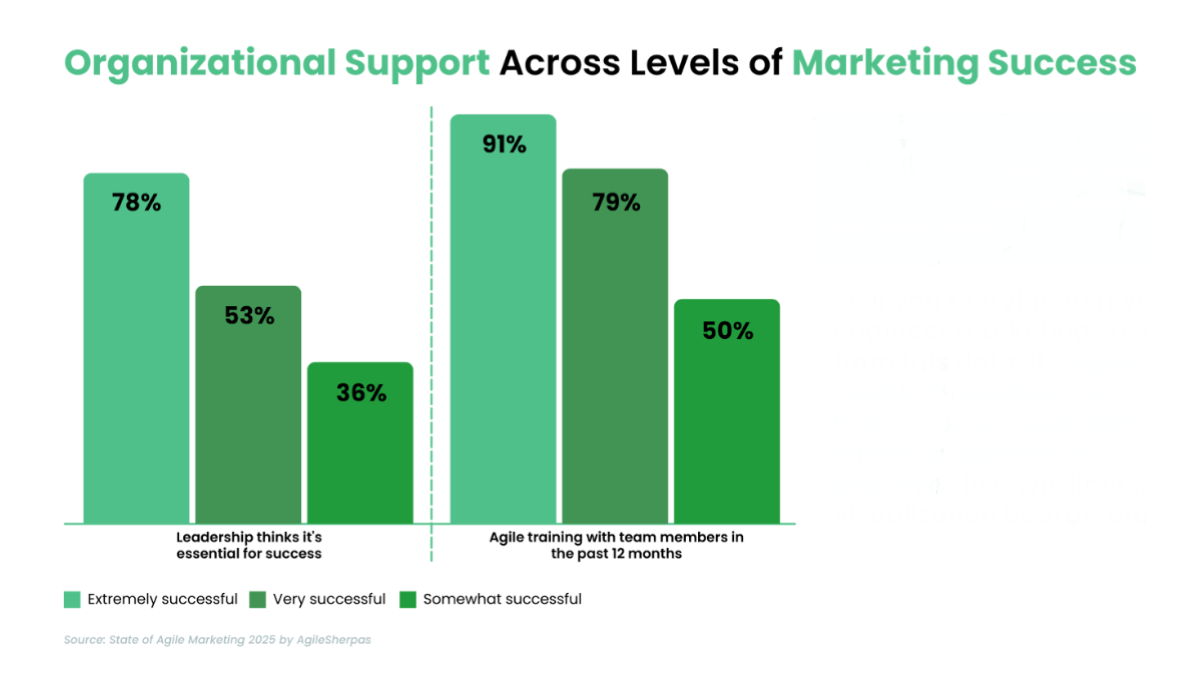
If you’re not an individual contributor, and/or have some level of influence over how your organization works, this next data point is for you.
Leadership attitudes toward Agile significantly impact success levels, so it’s important to ensure that your behavior makes your position clear. If you think Agile is essential for success, yet allow your peers to disrupt sprints with huge pieces of unplanned work, what you do is undermining what you (supposedly) believe.
Walk the walk if you’re going to talk the talk; otherwise, teams will become cynical about agility and assume it’s another management fad that will soon fade away.
Likewise, if you think Agile ways of working are useful, invest in educational activities for your team.
Individual learning moments are helpful, but bringing whole teams together occasionally can create an exponential impact. To provide this blended learning approach, AgileSherpas has recently launched an annual membership, which you can learn about here.
Benefits of Marketing Agility in 2025
As we’ve said before (and will continue to say pretty much forever), Agile is not a goal on its own. We change our ways of working to achieve distinct goals, and some of those are reflected in the benefits that our respondents shared with us here.
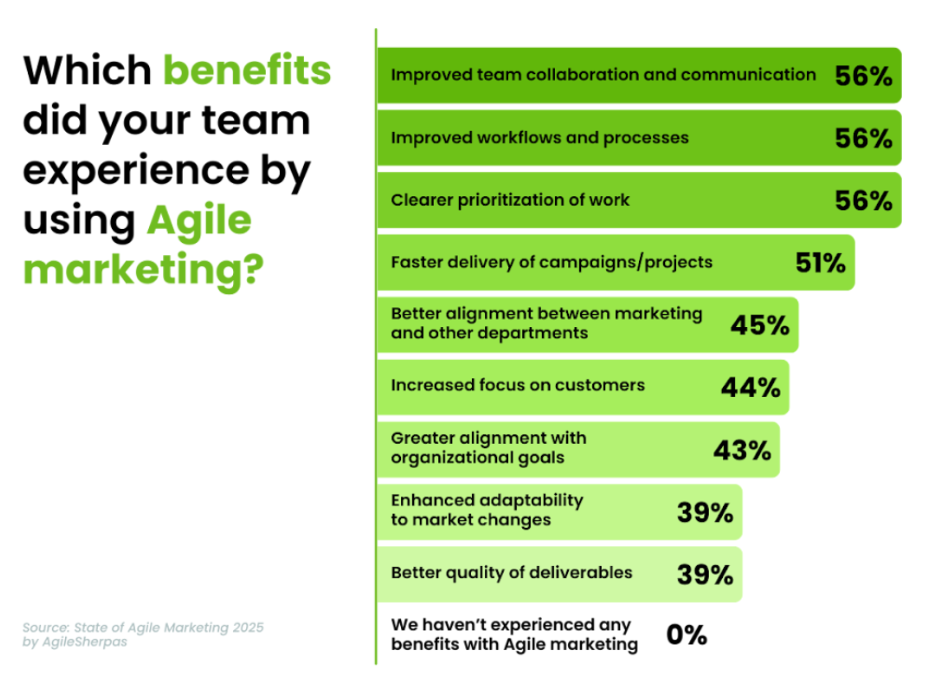
Thanks to its emphasis on visualized work and crossfunctional teams, Agile brings marketers stronger collaboration and communication, improved workflows, and better prioritization in equal measure.
(Keep in mind that in this particular question respondents could choose multiple benefits, which is why the numbers don’t add up to 100.)
It’s worth noting that while over half of the respondents felt an increase in their speed of delivering work, that wasn’t one of the top results. Many leaders look for higher volumes of work as a key outcome of Agile, but it doesn’t have to be present for agility to be working.

Non-Agile marketers are often concerned that sprints equate to stress. They see a rapid delivery cycle as a recipe for constant deadline drama, but this year’s data (as well as year over year trends in this report) contradict this assumption.
Instead, two-thirds of Agile marketers say that their new ways of working actually reduce their stress load.
And, as a great pairing, over three-quarters credit Agile as a big part of their coming success in 2025.
Again, “doing Agile” is not the goal. Achieving goals without burning out – that’s why we do the hard work of process improvement.
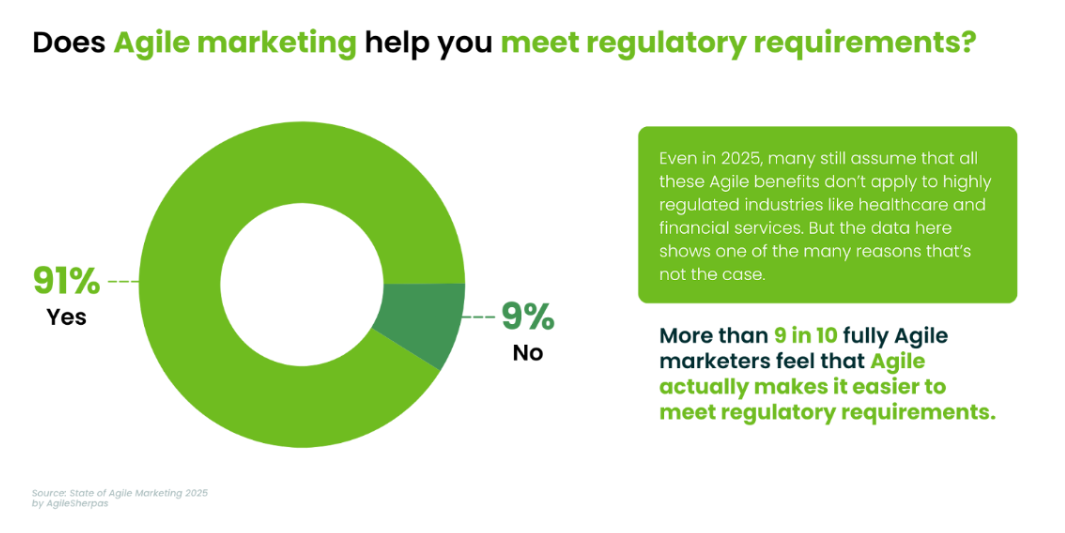
And speaking of the “why” behind process change, one of the biggest hurdles that marketers in regulated industries face is balancing speed with compliance.
Many of them assume that the complexities of regulation mean that Agile can’t work for them, but this year’s results put that ugly rumor to rest. It turns out that nine out of ten Agile marketers believe their processes help them to meet their regulatory requirements.
In my personal experience with clients, I’ve seen this to be true on many occasions, and that includes both pharmaceutical and financial industries.
Visibility and collaboration – both hallmarks of an effective Agile system – almost instantly improve flow despite regulatory complexity. And once those are in place, it makes further improvements easier and easier.

All of the above benefits should make these final stats utterly unsurprising. And, in fact, they’re both even better than what we saw in our 2024 data.
Marketers who have had a taste of agility don’t want to go back, and they’re having an overwhelmingly positive experience. If you’ve been on the fence, maybe these data points will push you over the edge.
How to Get Prepared for Your Agile Marketing Future
Agile is one of those concepts that’s easy to intuitively grasp, but hard to fully understand. So as you prepare to start or expand your usage, be sure to allocate some time and budget for education.
You’ll see here that free video courses are the most commonly used form of Agile marketing education, and there’s nothing wrong with this approach in certain situations.
In fact, AgileSherpas has a wide collection of free video learning that you can access right here.
But it’s important to balance the ease, availability, and popularity of these kinds of courses with data about their effectiveness.
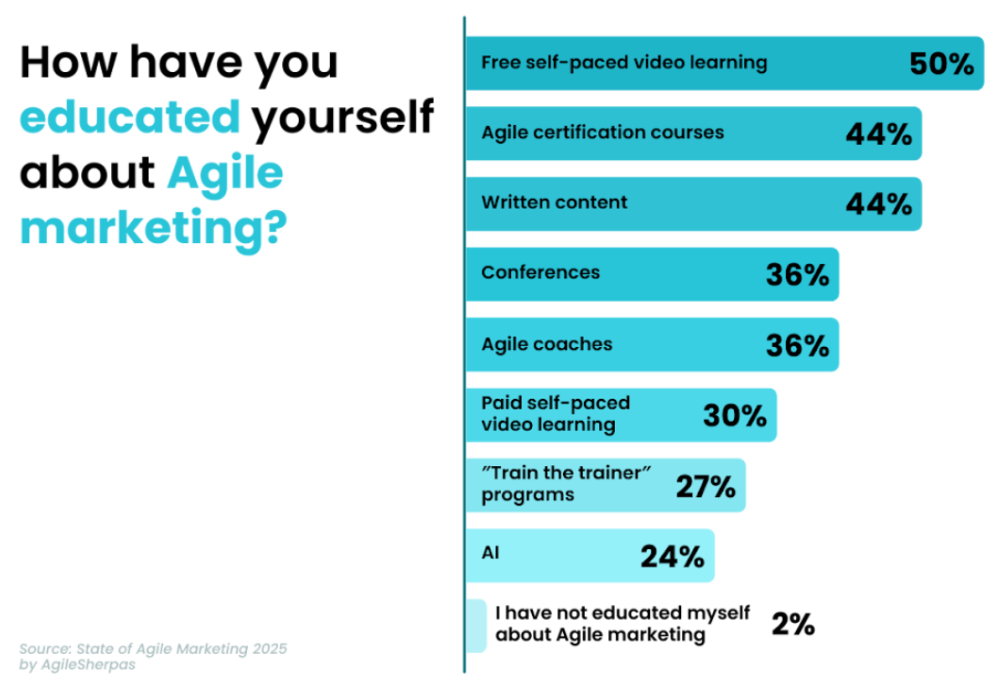
We ask our respondents to tell us not only which kinds of education they consume, but which ones they’ve found most useful. You can see the data changes dramatically across these questions.
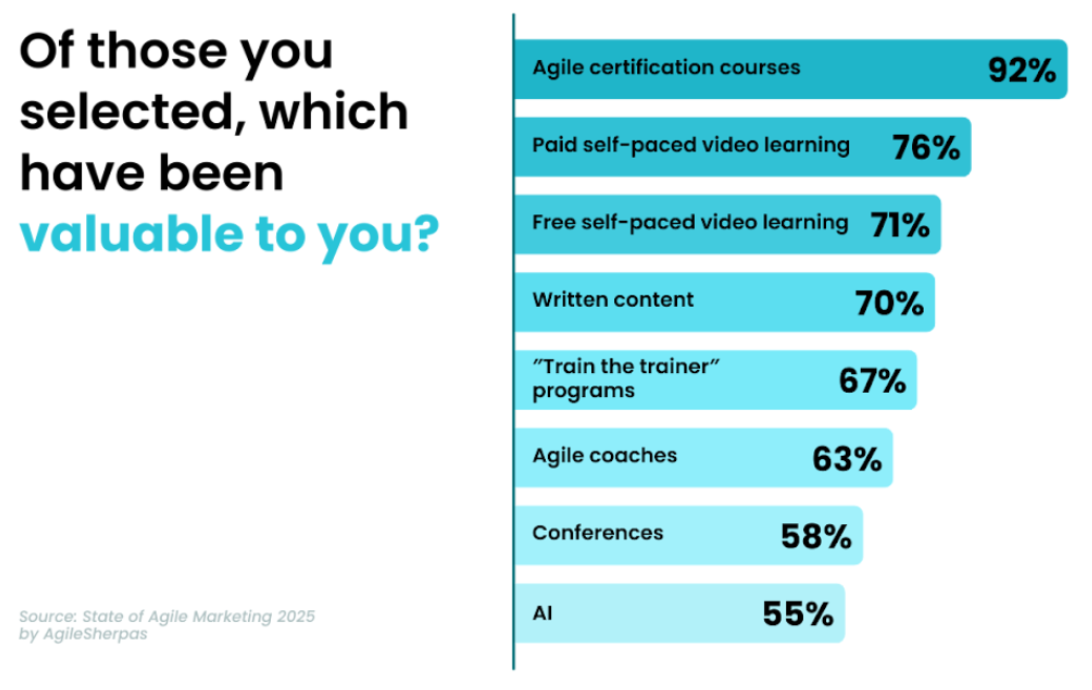
Nearly everyone who takes the time to go through a certification course of some kind finds it valuable; free video content trails that number by 21 percentage points.
Still, around three quarters of those who have used video learning found it valuable, so don’t dismiss this as a viable medium.
Finally, it’s worth noting that none of the options available were rated as valuable by less than half of our respondents. Which means that your chances are better than 50/50 that any investment in your Agile education will pay off.
Before you leave, get you copy of the 8th Annual State of Agile Marketing Report.